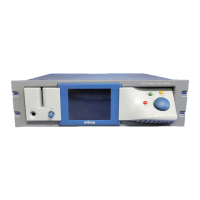OPTIMOD-FM OPERATION
3-61
various 8400 factory presets before making your own adjustments, so you can get a feel
for how we made the tradeoff between punch and distortion at the factory. If you set the
threshold much above –6 dB, you will typically get some distortion even on steady-state
waveforms (depending on where you have set the
Bass Clipper Thresh control).
This control is the primary means of trading off bass punch against IM distortion caused
the bass’ pushing non-bass material into the final clippers. Set it more negative for less
punch but less IM distortion.
There are two bass equalizer sections—the low bass shelving equalizer and the bass
parametric equalizer. The main thing to remember about these sections is that they are
fixed tone controls that apply coloration equally to all program material going into the
main dynamics processing section of the 8400. (They do not affect the AGC section, be-
ing located after it in the signal flow.) Accordingly, the five-band compressor in the 8400
will attempt to undo any coloration added in the equalizer setting and automatically re-
equalize the sound to the standard established by the band threshold controls.
Therefore, to get bass to survive the dynamics processing in the 8400, it is usually neces-
sary to apply substantial bass boost to the input by using the equalizer controls. (A small
amount of boost will just be "automatically re-equalized" away; check the factory presets
to see what we mean by “substantial.”) Bear in mind that using large amounts of shelving
bass boost (particularly with 12- or 18 dB/octave slopes) can cause an effective loss of
mid-bass because the band 2 compressor will be forced to produce additional gain reduc-
tion.
Another important control that affects bass is the
Band 1 Output Mix control. Because this
is located after the dynamics processing, the dynamics processing will not fight any ad-
justments you make to this control. However, the downside is that the bass compressor
will not act to prevent excessive drive to the clipping system (and consequent distortion),
so be very careful when boosting this control.
The crossover between band 1 and band 2 is adjustable to 100 Hz or 200 Hz by the
B1/B2
Xover
control. When the crossover is set to 100 Hz, band 1 affects extreme low bass (the
kind of bass that is not reproduced by small clock and portable radios), while band 2 af-
fects the mid-bass and lower midrange. Setting the crossover at 200 Hz will cause more
gain reduction to occur below 200 Hz because more energy is applied to the band 1 com-
pressor. If you now increase the fixed bass boost by using the
Low Bass equalizer with an
18 dB/octave slope and 120 Hz tuning, the net result will be a dynamic reduction of bass
power, typically centered around 160 Hz. If you use enough low bass boost, there will
also be a slight increase in the bass power below 100 Hz or so. This 160 Hz suck-out can
give an extremely solid, punchy bass sound on radios with good bass response (particu-
larly on radios with subwoofers) but may cause smaller radios to sound thin. (This is the
bass formula used in the two
GREGG presets.) The rest of the presets use the 100 Hz
crossover and have more mid-bass.
To wrap it up: Bass is a matter of preference, but the canny broadcast engineer will be
aware of the variability of radios out there and will not apply excessive bass boost that
can sound awful on "boom-boxes" and other consumer radios with bass boost already
built-in. It is usually wise to emulate the bass balance of hit CDs, because very experi-

